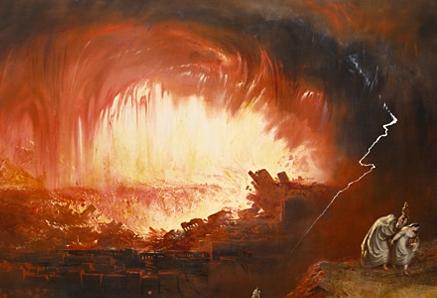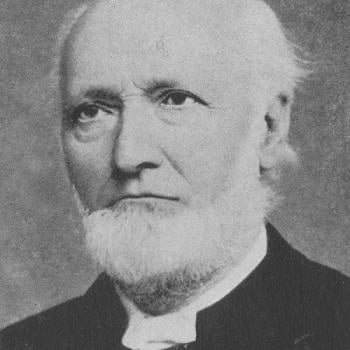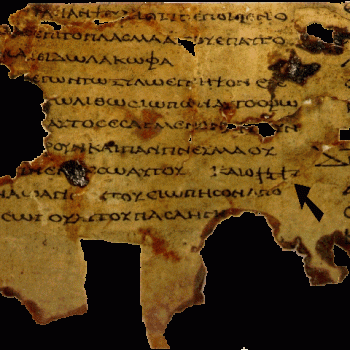The Destruction of Sodom and Gomorrah (1852), by John Martin (1789-1854) [public domain /
Wikimedia Commons]
***
(10-9-14)
***
Prior to the last ten years or so, the leading archaeological theory (for those who believe that these cities existed) placed the location of Sodom and Gomorrah on the south end of the Dead Sea, on the eastern shore; although there were several prominent archaeological advocates for a northeastern shore location as far back as the 19thcentury, and this was, in fact, the consensus location from the 4thcentury until the early 1900s.
*
The “buzz” and fun discussion currently taking place is largely the result of the Tall el-Hammam excavations in Jordan, led (beginning in 2006) by archaeologist Dr. Steven Collins, Dean and Professor at Trinity Southwest University. He has written voluminously and passionately about his positions.
Dr. Collins is also an evangelical Protestant who takes Scripture very seriously as historically accurate and inspired;but apparently not a conservative enough one in the eyes of some of his critics, who dispute not only his proposed location, but the chronological scheme that he holds. Dating in particular always involves some speculation and subjectivity, so it shouldn’t surprise anyone that vigorous debates occur along those lines.
*
These differences have led to some very lively public exchanges, with at least one of his detractors in the field even questioning his academic credentials (which appear to be quite impressive ), and his counter-charge that the same critic accepts a young earth chronology that skewers their biblical interpretation (in turn denied).
*
In other words, it’s the usual academic wrangling: generally entertaining, but sometimes boorish and tedious to observe. Scholars (despite some of their own “press reports”) are not completely objective machines. They have strong opinions and vigorously react to criticisms: especially those thought to be unjust and unfair. And they have biases and emotions, just as we all do.
*
The Popular Archaeology site provides a helpful introductory overview of these developments :
*
The team, led by Dr. Steven Collins of Trinity Southwest University and Hussein el- Jarrah of the Department of Antiquities of the Hashemite Kingdom of Jordan, will be excavating a large mound (“Tall” or “Tel”) called Tall el-Hammam, located amidst agricultural fields northeast of the Dead Sea in the southern Jordan River Valley. . . .
*
One curious, puzzling mystery relates to the layer that shows no human occupation for 500 to 700 years. . . .
*
Another curiosity relates to an extraordinary pottery sherd (or fragment), found within the ash “destruction” layer, which features a striking and unusual glazed appearance (see video below). Pottery glazing has not been found on pottery until more than 1,000 years later than the date of the sherd. Laboratory testing and analysis of the fragment shows that it was apparently exposed to extremely high temperatures, a level that far exceeds that normally used to fire and treat pottery, ancient or modern, and that also far exceeds temperatures typically reached during fires. Such temperatures could be produced, for example, by the effects of a thermonuclear explosion, or a cataclysm of cosmic origin.
*
Catholic professor of theology John Bergsma wrote on The Sacred Page (a wonderful Catholic website) about his enthusiasm over stumbling into a fascinating lecture about these excavations at an academic conference:
*
The sites fit the geographical and temporal context into which Sodom and Gomorrah are placed in the biblical texts. The cities at the site were suddenly and completely wiped out in the Late Bronze Age, which makes a reasonably good fit with the biblical accounts of Abraham and Lot. The entire presentation was very convincing, but never once did they deal with the “elephant in the room”: what caused the sites to be suddenly abandoned? As soon as the session was over, I was the first to raise my hand. “Did you find any arrow heads? Signs of invasion? What happened to them?” The lead archeologist paused for a moment. “I didn’t want to go there,” he said. Another pause. “I’m preparing material for publication.” Pause. “All I want to say ‘on camera’ is, they appear to have been wiped out in a ‘heat event’.”
*
Dr. Collins showed up in the comments for the article. After greatly emphasizing the need for as objective and scientific as possible analysis, and his desire for triple-blind studies by three or more parties, he was willing to comment further on the “heat event” (and all students of the Bible know where that might potentially lead):
*
On our terminal MB2 event, what I can say is that multiple lines of evidence continue to confirm that not only massive Tall el-Hammam, but also its many satellite towns and villages on the eastern Kikkar, suffered some sort of fiery, civilization-ending cataclysm toward the end of the Middle Bronze Age, with the selfsame, well-watered-in-abundance area remaining devoid of settlements for the next 600 years or so . . . The entirety of Tall el-Hammam’s MB2 footprint is covered in heavy ash (from .5m-1m thick), ash filled destruction debris, and other conflagratory indicators that will be published in appropriate venues. . . .
*
Is Tall el-Hammam biblical Sodom? Well, if it isn’t (and I say this with complete confidence in what I know to be the facts of the case), there are going to be a lot of people with a lot of ‘splainin’ to do, Lucy! In the meantime, I welcome rational discourse pro and con (emphasis on rational!).
*
Brian Nixon, of Assist News Service, wrote about the same subject matter, a day after the article above :
*
In my article “Sodom Found?” I wrote, “According to Collins, ‘The traditional “Southern Theory” site of Sodom does not have the geographical parallels described in the [biblical] text. Namely: 1. One can see the whole area from the hills above Jericho (Bethel/Ai), 2. It must be a well-watered place (described “like Egypt”), 3. It has a river running through it (the Jordan), and 4. It must follow the travel route of Lot” (who went to the other side of the Jordan, eastward, away from Jericho.)’”
*
What does all this mean? Simple: The traditional sites attributed as Sodom may be incorrect.
*
He cited Dr. Collins, summarizing some of the findings of the dig in the year 2010:
*
“To start with, the Tall el-Hammam site has twenty-five geographical indicators that align with the description in Genesis. Compare this with something well known—like Jerusalem—that has only sixteen. Other sites have only five or six. So this site has a greater number of indicators than any other Old Testament site. That is truly amazing.
*
“Second, our findings—pottery, architecture, and destruction layers—fit the timeframe profile. Meaning we should expect to find items like what we are finding from the Middle Bronze Age. This is exactly what we are uncovering.
*
“Though . . . much research still needs to be conducted, I feel that the evidence for this being the ancient city of Sodom is increasing by the day.”
*
Collins then went on to describe interesting skeletal finds from the dig in early 2011: indicating some sort of sudden and city-wide catastrophe:
*
“[T]he real big news is that we found skeletal remains that demonstrate a quick, violent death. . . . In short, the bodies were extremely traumatized in their death. . . . skeletal remains were found throughout the area, following the same patterns.”
*
Bob Haynes, writing on the Fundamentally Reformed website , offers readers another helpful overview of these matters, in the course of his review of Dr. Collins’ book, Discovering the City of Sodom (co-author Latayne C. Scott; New York: Howard Books / Simon & Schuster: 2013):
*
Collins explains why others have not looked for Sodom in this locale. It is chiefly due to theories that Sodom was under the Dead Sea or to be found on its southern shores. Ultimately these theories were based less on evidence than on unsubstantiated educated guesses from earlier and still renowned biblical archeologists. Further data has contradicted the assumption that Sodom was in the barren wasteland of the southern Dead Sea – which was never (during the time of the Biblical Sodom) an Edenic paradise that was to woo Lot to pitch his tent there. . . .
*
The book ends with the most exciting find of all: pottery shards that are superheated to glass on one side, yet are perfectly normal pottery on the other. The conclusion of experts is that the shards were super heated and then cooled far too rapidly than would be expected by any typical human furnace or heating method known in ancient times. Extensive, independent research compares this to molten sand left over after nuclear experiments and the green glass found in the desert at times due to meteoric events. The best physical explanation is a meteor that burned up in the atmosphere leaving no crater, but still sending a fireball to earth (as in a documented case in Siberia in the early 1900s). This may very well be concrete proof that the story of Sodom’s fiery demise as recounted in the Bible is true.
*
. . . Along the way he presents an excellent example of how to hold true to Scripture and yet still seek to pursue a path of valid scientific inquiry.
*
This book is garnering many rave reviews from others in the field, as we see from these two on its Amazon web page:
*
Dr. Collins is a meticulous archaeologist with an extraordinary team of specialized scholars who are not afraid to challenge the traditional assumptions about the location and fate of the Bible’s most mysterious city—Sodom. His findings are scholarly, fascinating, educational, and extremely convincing to anyone who needs hard facts to support their conclusions regarding this famous city. The massive accumulation of the archaeological and geographical data from Tall el-Hammam, and its surrounding territory, leaves little doubt in my mind that Dr. Collins has emerged as the authority on the identification of Sodom. This riveting account of Dr. Collins’ fascinating journey and discovery has contributed a unique body of knowledge that surpasses anything published on the subject. I don’t know of a more convincing case for Sodom’s long-awaited identification. (Joseph M. Holden, Ph.D., President of Veritas Evangelical Seminary and co-author The Popular Handbook of Archaeology and the Bible)
*
In this book, Collins provides the most complete discussion to date of all of the relevant biblical texts. The most compelling part of the book is Dr. Collins’ argument for locating Sodom northeast of the Dead Sea, rather than further to the south as many have assumed. This book will engender a great deal of interest among the general public, but it is likely to be received with less enthusiasm by many specialists in the field. Even so, it is clear that Dr. Collins has thought very deeply about the relationship between his site and the biblical narrative. Much of the skepticism about the historicity of Sodom over the years has been conducted in an archaeological vacuum. (Robert A. Mullins, Ph.D., Professor of Archaeology and Old Testament, Azusa Pacific University)
*
As early as 26 March 2007, Dr. Collins was confident enough in his findings to assert:
*
At this point, I am willing to say that if Tall el-Hammam’s identification as biblical Sodom is still denied after an examination of the growing body of evidence to that effect, then the identification of every single biblical site not confirmed by specific epigraphic evidence must me called into question.
*
Phil Silvia, Field supervisor for the Tall el-Hammam excavations, provides a more specific conjecture as to the cause of the city’s demise at the end of the Middle Bronze Age (c. 1700 B. C.):
*
We are convinced, but not yet ready to discuss the details (this will be the subject of my doctoral dissertation), that this civilization ‐ ending catastrophic event was the result of an air burst explosion, probably from a comet or comet fragment since there is no crater anywhere in the area to suggest a meteor. The archaeological evidence that we are finding strongly points to this type of a destructive event.
*
The Bible describes the destruction of Sodom and Gomorrah as follows:
*
Genesis 19:24-25 Then the LORD rained on Sodom and Gomor’rah brimstone and fire from the LORD out of heaven; [25] and he overthrew those cities, and all the valley, and all the inhabitants of the cities, and what grew on the ground.
*
Silvia had noted in his paper that at least five surrounding cities and also Jericho, a little ways across the river, had been destroyed at the same time. This is consistent with the biblical account, as anyone can plainly see.
*
Bible History Daily: the website of the Biblical Archaeology Society, took note of the extraordinary nature of the destruction of this ancient city in a similar fashion:
*
Across Tall el-Hammam, archaeologists found widespread evidence of an intense conflagration that left the Middle Bronze Age city in ruins. They found scorched foundations and floors buried under nearly 3 feet of dark grey ash, as well as dozens of pottery sherds covered with a frothy, “melted” surface; the glassy appearance indicates that they were briefly exposed to temperatures well in excess of 2,000 degrees Fahrenheit, the approximate heat of volcanic magma. Such evidence suggests the city and its environs were catastrophically destroyed in a sudden and extreme conflagration.
*
Prominent biblical anthropologist Alice C. Linsley noted on her blog, Just Genesis, the earlier scholarly advocates of a similar location for Sodom:
*
Collins has received much attention by claiming that Tall el-Hammam is the true Sodom, or what scholars call the “Sodom of the north.” However, he was not the first to suggest this possibility. In the late 19th century [Henry B.] Tristram, [Claude R.] Conder, [Selah] Merrill and [William M.] Thomson made a case for a location north of the Dead Sea in the southern Jordan Valley.
*
Dr. Collins has noted that in the 19thcentury most “explorer-scholars” held this view. In addition to the above, he cites Charles W. Wilson, H. H. Kitchener, George Grove, and Henry S. Osborn.
*
The real fun begins with the interaction of Dr. Collins and his critics, who favor the “southern theory” of the location of Sodom. He has engaged in quite a bit of back-and-forth with Dr. Todd Bolen, professor of archaeology at The Master’s College. Dr. Bolen’s BiblePlaces Blog has run a number of articles on the topic, and Dr. Collins is usually very prominent and verbose in the comments section.
*
We shall survey some of this, but nowhere near comprehensively. Space considerations don’t permit a full description of competing theories, so I will mainly highlight Dr. Collins’ replies to other points of view and criticisms of his thesis. I urge readers to consult the referenced articles to read much more of both perspectives. Dr. Bolen proclaimed in an article dated 13 May 2006:
*
I know from previous study that of the three possible regions for the location of Sodom and Gomorrah based on all of the Scriptural evidence (northeast, southeast, under the Dead Sea), the least likely is the northern theory.
*
Dr. Collins fired back in a comment on 21 June 2006:
*
Every argument for a southern Sodom is ludicrous. . . . I guarantee that the southern location for Sodom will die in time, as painful as it might be for some people who’ve married themselves to an untenable, traditional theory. I’m sorry, but there is simply zero evidence of any kind to support it!
*
Again, on 10 August 2009, Dr. Bolen provides a dissenting opinion on his blog:
*
Finding ancient sites that have Middle Bronze occupation and then a gap until Iron Age is not difficult. That’s what Collins has found. This and the others in the area are no doubt important sites, but it does not fit the biblical data about Sodom.
. . . With regard to the Middle Bronze occupation, . . . you must revise the biblical dates in order for Collins’ identification to match the archaeology. He lowers the date of Abraham in order to create a match with his excavation results. The traditional biblical dating of the destruction of Sodom is approximately 2100 BC, . . .
*
Dr. Collins replied in comments on 18 August:
*
As for the chronology, Albright, Kitchen, and a host of other scholars would place Abraham much later in the MB. That’s because they realized the formulaic nature of the patriarchal life-numbers, and took a late date for the Exodus.
*
And again in another comment on the same day:
*
The later date for Abraham is preferred by a majority of chronographers, including Finegan. The early date for Abraham can be supported ONLY by the Masoretic reading of Ex 12:40 . . . I came to this conclusion long before I ever thought about the Sodom issue. I have never “cooked” any set of data to accommodate my Sodom theory. I always go with the reasonable facts, whether biblical, geographical, or archaeological. To this point, all the factually-based data are in leaning in our direction. All the counter arguments are simply non sequiturious, like the “can’t be anyone living on the Kikkar during the Iron Age” one.
*
By 19 December 2011, Dr. Bolen appears to be frustrated with Dr. Collins and his arguments, and decides to question his academic credentials (“Collins appears to be a professor of archaeology who has never earned a degree from a school with an archaeology program,” etc.).
*
He then reiterates his basic objections based on what he sees as seriously erroneous chronology and dating of Abraham, Lot, and Sodom’s destruction (400-500 years later than his own).
*
Dr. Collins defended his credentials in a reply dated 8 March 2012:
*
Indeed, my doctorates are in biblical hermeneutics and religion. But it is a fact that many of us who have enjoyed long careers as field archaeologists do not hold PhDs in archaeology per se. Much excellent work in archaeology has been accomplished by men with doctorates in theology, religion, biblical studies, Old Testament, history, and other branches of the social sciences. I could cite quite a long list. . . . let’s keep this discussion intelligent and academic, shall we?
*
Dr. Bolen claimed that Dr. Collins was twisting the chronology of the Bible like a wax nose, in order to fit into his theories, and (in a comment on 11 March 2012) even strongly insinuating that the quick identification of Tall el-Hammam as Sodom was a ploy “to bring millions of dollars and hundreds of volunteers to the site.” At length he decided (in comments on 12 March 2012) to pull out all the stops and lob outright character attacks:
*
I have detected for as many years as I’ve been reading what you’ve written about Sodom that the issue is not the evidence but your authority. You ask other people to believe you in spite of the evidence.
*
. . . You are a dishonest man. You twist the truth in order to deceive.
*
. . . That’s nine factually inaccurate statements in one paragraph. . . . If you were my student, I’d send you back to the library to open up a few books. You, however, know the facts but are purposefully distorting them to support your own agenda. I am unhappy with myself for spending my time in responding to you.
*
. . . A better approach is to trust the Bible.
*
Dr. Collins (in a comment on 13 March 2012) remained quite calm after this onslaught, asserting only that his words were being twisted and ignored. He ended by saying, “I do respect the views you hold regarding chronology. I used to have the same views. . . . I suppose that we will just have to agree to disagree on many points.” Dr. Bolen ended (on the same day) the now tedious and soiled discussion by tossing more insults:
*
What you really mean is “I’m humiliated by the exposure of my false statements before, but I am unwilling to admit it, so I will pretend there is another reason.” . . . I don’t think you can act unethically, refuse to repent, and then assume that we can just “agree to disagree.” . . . when one distorts the truth, twists the words of others, and is very calculated in his efforts to deceive, I am not going to pretend otherwise or continue the conversation.
*
And so it often goes, even in academia (though this is a pretty striking instance). I’m very familiar with this sort of “discussion downgrading into a mud fight” from my own countless dialogues in my apologetics work. In my opinion, Dr. Bolen lost the combox debate by default, in resorting to personal attack. This unsavory behavior indicates to me that his case is quite likely weak; otherwise he could have confidently stuck to assertion of his theories rather than ad hominem attacks.
*
Also, I’ve long observed that when one Christian thinks (rightly or wrongly) that another is more “liberal” than they are on some matters (in this instance, biblical dates and chronology), often they assume that it is because of dishonesty or lack of faith in biblical inspiration. That seems to be what lies behind Dr. Bolen’s personal contempt.
*
In any event, the vigorous scholarly debate about the location of Sodom and Gomorrah looks to be one of the more interesting ones in archaeology, over the next several years. Other archaeologists who claimed to have found things that seem to be primarily supported by the Bible have found themselves outcasts in their own field. Secular and anti-Christian strains still run strong in Ancient Near Eastern (“biblical”) archaeology.
*
Dr. Collins, however, seems like the type of person who won’t let such empty threats and negative possibilities daunt him in his quest for both biblical and archaeological truth: in harmony with each other. Whether one agrees with his conclusions or not, he is to be praised for his dual respect for scientific method and for the inspired revelation of Holy Scripture.
*
FOOTNOTES
*
*
*****
***
*
*
Or you may believe my work is worthy to support for the purpose of apologetics and evangelism in general. If so, please seriously consider a much-needed financial contribution. I’m always in need of more funds: especially monthly support. “The laborer is worthy of his wages” (1 Tim 5:18, NKJV). 1 December 2021 was my 20th anniversary as a full-time Catholic apologist, and February 2022 marked the 25th anniversary of my blog.














